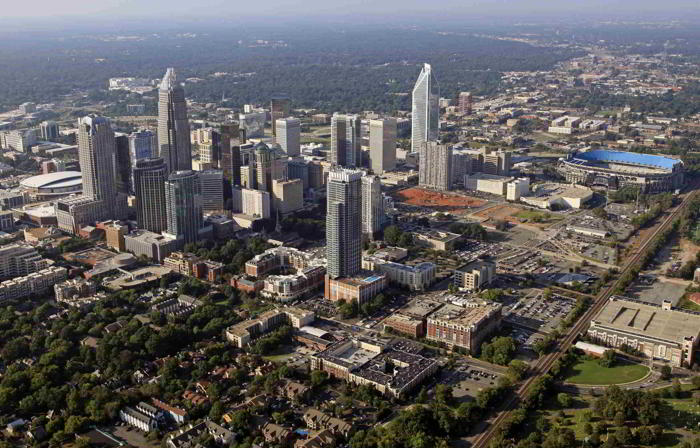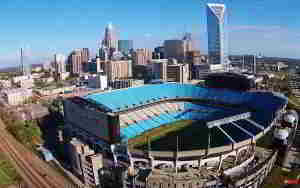|

In the hopes of currying favor with King George III, the area’s settlers named their town Charlotte, after the king’s wife. Located in the new county of Mecklenburg along the Catawba River in south central North Carolina, Charlotte became known as the “Queen City." English-Irish immigrants came upon the area while traveling on the Great Wagon Road from Philadelphia.
Today, Charlotte is the second largest metropolitan area in the Deep South, to Atlanta, and is the second largest banking center in the country, behind New York City.
Colonial Charlotte
By the 1600s, the Charlotte area was already home to the Catawban Indian tribe which means “people of the river", who had established living areas along the river. Fleeing their enemies in 1640, the Catawban were once part of the Sioux Indian Nation in the great western Plains.
Beginning in the 1750s, Catawban Chief Hagler worked to establish peaceful relations with the new white settlers. For his trouble, he was killed by a neighboring Shawnee war party, who didn’t want peace. In 1763, the British negotiated a land deal with the Catawban, for 144,000 acres along the Catawba River that would be set aside for the

Mecklenburg County was so named after the queen’s German homeland. Charlotte Town, as it was known, then incorporated in November 1768. The locations of Charlotte’s streets were platted by surveyors into four sections, called wards, in 1770. These wards are still part of Charlotte’s architectural landscape.
During the Revolutionary War, British commander Lord Charles Cornwallis was met by a band of 150 soldiers at the Mecklenburg County Courthouse in September 1780. Although Cornwallis was initially successful in holding the territory, his regime was later overturned.
At the Battle of King’s Mountain just southwest of Charlotte on the South Carolinaborder, frontiersmen from Georgia, Virginia, and both Carolinas combined for a victory over the British, in a highly significant skirmish on October 7, 1780. The the epic battle, in which the British sustained heavy casualties, was recognized as being instrumental in bringing the War of Independence to an end.
Gold!
The first-ever gold rush, in what would become several gold rushes throughout the new country, began in Charlotte, where the first verified finding of gold in the U.S. was located. With the discovery of a 17-pound nugget in 1799, the town experienced a temporary boom as prospectors flooded Charlotte. The nation’s first gold mine was operated by Reed Gold Mine, until 1914. Before the boomlet petered out, a number of productive veins were found. Mining continued to a lesser degree, on those veins that were found in the area, but, beginning in 1849, most of the miners broke camp and moved west to try their luck in the California gold fields.
During the Civil War, Charlotte became the new location of the Confederate Navy Yard, where 1,500 Mecklenburg county men and boys gathered to manufacture munitions and gunpowder. The yard had moved from Richmond, Virginia, and was opened in Charlotte in 1862, in an attempt to create more distance between it and Union soldiers and sailors, and to be in closer proximity to the iron works.
After the death of Confederate General “Stonewall" Jackson at the battle of Chancellorsville, Virginia, in 1863, his widow Anna, moved to Charlotte to raise their daughter.
On April 20, 1865, sensing the South must soon give up its fight for independence, CSA President Jefferson Davis held his last meeting with the entire Cabinet, at the home of Williams Phifer, instead of at their regular headquarters at the Charlotte branch of the Bank of North Carolina.
The 20th Century
In the 1970s, Charlotte’s modern banking industry reached prominence, spurred by visionary financier Hugh McColl, who transformed North Carolina National Bank into a nationwide competitor that eventually became part of Bank of America. In addition, the First Union Bank in Charlotte eventually became Wachovia Bank, now one of the nation’s largest and a major competitor of Bank of America . .
The four wards that made up the original town of Charlotte are currently called the Uptown area. In the center of Uptown is its town square where the corners of all four wards meet. In the first and fourth wards, Charlotte’s remaining 19th century Queen Anne architecture are a major tourist attraction, while the first and third wards are where the financial buildings and business center are located. Bank of America Stadium, which is the home of the NFL’s Carolina Panthers; the Charlotte Bobcats Arena; Johnson & Wales University; and the Museum of the New South are all located in Uptown, along with the city and county government buildings.
Rich in history, Charlotte has many diverse museums. The Mint Museum of Art, founded in the old Charlotte Mint building in 1936, is North Carolina’s oldest art museum. Its companion is the Mint Museum of Craft and Design which opened in 1999, and focuses on items that delineate historical, technical, and stylistic innovation. Charlotte is also home to the Mint Hill Country Doctor’s Museum, the Museum of the Old South, and the Carolinas Aviation Museum.
Many of Charlotte’s higher learning institutions were built prior to the Supreme Court’s decision on Brown vs. Board of Education. Area colleges and universities include the University of North Carolina at Charlotte and the historically black college Johnson C. Smith University, which was once called the Biddle Institute. Charlotte is also home to Central Piedmont Community College, Kings College, Pfeiffer University at Charlotte, and Queens University of Charlotte.
Charlotte was once known as the “City of Churches," and is the birthplace and home of world-renowned evangelist, Billy Graham. With more than 700 places to worship, Charlotte’s highest concentration of adherents are Protestant Christian, with the most prevalent being the Presbyterian and Methodist denominations. With the relocation of many corporations from the northeast in the 1980s, Catholic and Jewish populations grew substantially. There is also a large population of Baptists, and there are five mosques located here, as well.
This article is compliments of US history.com
We thank them sincerely for the important work that they do.
And we strongly encourage you to support them and their advertisers.
https://www.u-s-history.com/pages/h3876.html
|